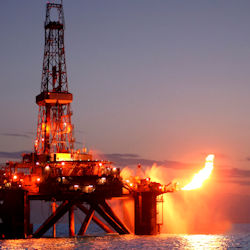Class B Combustibles
These include flammable and combustible liquids (oils, greases, tars, oil-based paints, and lacquers), flammable gases, and flammable aerosols.
Handling Class B Combustibles
To handle Class B combustibles safely:
- Use only approved pumps, taking suction from the top, to dispense liquids from tanks, drums, barrels, or similar containers (or use approved self-closing valves or faucets).
- Do not dispense Class B flammable liquids into containers unless the nozzle and container are electrically interconnected by contact or by a bonding wire. Either the tank or container must be grounded.
- Store, handle, and use Class B combustibles only in approved locations where vapors are prevented from reaching ignition sources such as heating or electric equipment, open flames, or mechanical or electric sparks.
- Do not use a flammable liquid as a cleaning agent inside a building (the only exception is in a closed machine approved for cleaning with flammable liquids).
- Do not use, handle, or store Class B combustibles near exits, stairs, or any other areas normally used as exits.
- Do not weld, cut, grind, or use unsafe electrical appliances or equipment near Class B combustibles.
- Do not generate heat, allow an open flame, or smoke near Class B combustibles.
- Know the location of and how to use the nearest portable fire extinguisher rated for Class B fire.
Source: Hazard Communication - Small Entity Compliance Guide.
Water should not be used to extinguish Class B fires caused by flammable liquids. (See Photo) Water can cause the burning liquid to spread, making the fire worse. To extinguish a fire caused by flammable liquids, exclude the air around the burning liquid. The following fire-extinguishing agents are approved for Class B combustibles: carbon dioxide, multi-purpose dry chemical (ABC), halon 1301, and halon 1211.
Class D Combustibles
Locations where combustible metal powders, flakes, shavings, or similarly sized materials are generated at least once every two weeks must install Class D portable fire extinguishers not more then 75 feet from the hazard.
Class K Combustibles
Due to the higher heating rates of vegetable oils in commercial cooking appliances NFPA 10, Portable Fire Extinguishers, now includes a Class K rating for kitchen fires extinguishers which are now required to be installed in all applicable restaurant kitchens. Once a fire starts in a deep fryer, it cannot always be extinguished by traditional range hoods or Class B extinguishers.
Knowledge Check Choose the best answer for the question.
2-6. Which of the following classes of combustibles includes flammable and combustible liquids (oils, greases, tars, oil-based paints, and lacquers), flammable gases, and flammable aerosols?
You forgot to answer the question!

